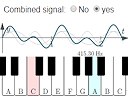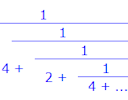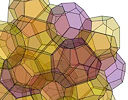IntMath Newsletter: Piano trig applet, continued fractions
By Murray Bourne, 31 Jul 2017
31 Jul 2017
In this Newsletter:
1. New applet: Piano note frequencies interactive
2. Resource: Continued fractions
3. Math in the news: Space filling
4. Math movie: One in a million
5. Math puzzle: clock
6. Final thought: Really worth the doing
1. Frequencies of notes on a piano - interactive learning object
 |
Explore piano note frequencies in this new interactive learning object, combining trig graphs and exponential growth. |
Here's some background on what's going on:
What are the frequencies of music notes?
Frequency of notes on a piano - interactive learning object
2. Resource: Continued Fractions
You may recall the Euclidean Algorithm for finding the greatest common divisior of 2 numbers. For example, the GCD of 93 and 42 would be found as follows:
93 = 2 × 42 + 9
42 = 4 × 9 + 6
9 = 1 × 6 + 3
6 = 2 × 3 + 0
We stop at that last line because there is a remainder of 0, and we conclude the GCD is 3.
Continued fractions are a special form of fraction and can be used when finding GCDs, as well as in many other applications like finding square roots and solving quadratic equations.
 |
This extensive resource covers continued fractions. It contains many worked examples and several online calculators and it's by Richard Knott, Surrey University: |
3. Math in the news: Space filling
Fruit shop owners know a thing or two about space filling. They need to display their wares attractively, safely and in a space-efficient way.

Mathematicians have studied space filling for some years, especially since
Lord Kelvin (the temperature guy) asked in 1887:
How can space be partitioned into 3D structures of equal volume in a way that minimizes the total surface area of each structure?
Some Belgian mathematicians had some breakthroughs on this issue last year. From Phys.org:
4. Math movie: How to visualize one part per million
A lot of people struggle with very large (or very small numbers). It's not surprising as most of us don't use them every day, but as we do hear about them constantly on the news, it's important to get a good conception of them.
 |
In this short TED-Ed video we get some good pointers on what one million really looks like.
How to visualize one part per million
|
5. Math puzzles
The puzzle in the last IntMath Newsletter asked how far a person walked given some (seemingly) insufficient conditions.
Correct answers with explanation were provided by Chris, Thomas and Nash.
The walking problem was based on one by Lewis Carroll, author of Alice in Wonderland, and Through the Looking Glass. It appeared in his book A Tangled Tale. Apart from being a well-known author, Carroll (real name Charles Lutwidge Dodgson) was a mathematician, logician, Anglican deacon, and photographer.
New math puzzle: Clock
True or false? Consider a clock at 11:40 AM. When the second hand reaches somewhere close to 20 seconds past the minute, the clock face will be divided into 3 equal parts. How about for any other cases (like close to 01:45:30, or 02:50:35)? Is it true? Can you prove your conclusion for the clock at any time?
You can leave your responses here.
6. Final thought: Really worth the doing
Today's quote is from Lewis Carroll:
One of the secrets of life is that all that is really worth the doing is what we do for others.
Until next time, enjoy whatever you learn.
See the 7 Comments below.

1 Aug 2017 at 12:36 am [Comment permalink]
False.
An equal 3 part division for the hands of the clock would be 120 degrees (360/3). The hour hand at 4 and 8 would have the minute hand pointing at 12. However, the second hand must also be at 12 at those times. There is no perfect integral or congruence given the ratio with the 3 hands of a clock to form an equal 3 part division.
Rick
4 Aug 2017 at 2:49 pm [Comment permalink]
I'm sorry, Dave. I'm afraid I can't do that.
Something messed up. :-(